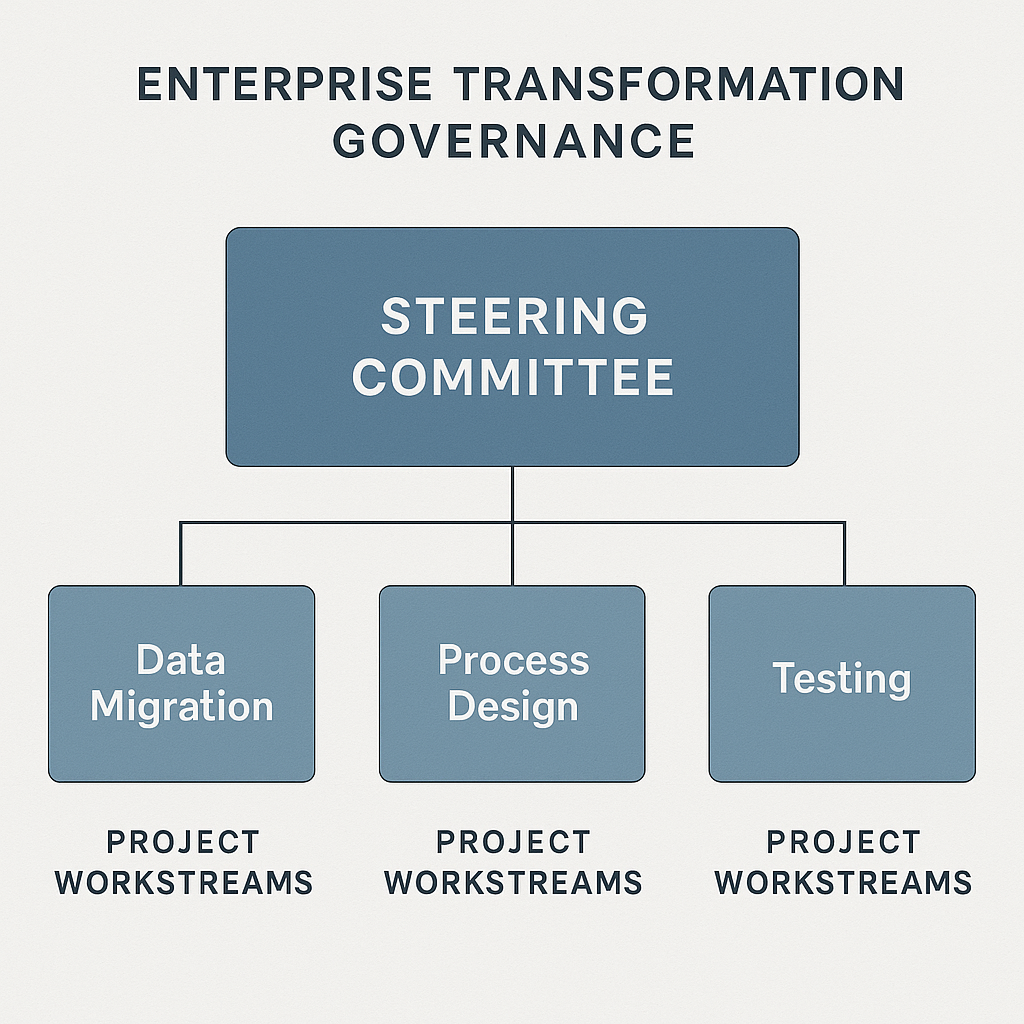
Table of Contents
Why do so many large-scale enterprise system transformations go off the rails? After observing dozens of these high-stakes projects, my analysis consistently points not to technological failure, but to a breakdown in governance. Organizations often mistake project management for governance, focusing on timelines and tasks while losing sight of the strategic decision-making framework that truly determines success.
Effective governance is the scaffolding that supports the entire transformation. It’s about creating a structure for making smart, timely decisions, managing risk, and ensuring the project remains relentlessly focused on delivering business value. Without it, even the most technically brilliant implementation can drift into a morass of scope creep, budget overruns, and stakeholder dissatisfaction.
The Steering Committee’s True Role: Beyond Status Updates
The Steering Committee serves as the cornerstone of any governance model, yet its role is frequently misunderstood. In struggling projects, this committee often devolves into a passive body that simply receives status updates. This is a massive missed opportunity, isn’t it?
A perspective forged through years of navigating these transformations suggests that a high-functioning Steering Committee acts as the ultimate arbiter of strategic trade-offs. Its primary job isn’t to review Gantt charts; it’s to make the tough calls. This includes resolving cross-functional resource conflicts, approving material changes to scope (with a very high bar for justification), and decisively removing organizational roadblocks that the project team can’t overcome on its own. They are the guardians of the project’s strategic intent.
The Design Authority: The Architectural Conscience
Beneath the strategic oversight of the Steering Committee, a Design Authority is crucial for maintaining technical and process integrity. This cross-functional group, typically composed of enterprise architects, senior business process owners, and security experts, serves as the project’s architectural conscience.
Their mandate? Ensure that individual design decisions, often made within separate workstreams, adhere to a cohesive, enterprise-wide vision. They ask the hard questions. Does this proposed solution align with our long-term data strategy? Does this customization create unacceptable technical debt? (A challenge I’ve explored in-depth regarding ERP customization realities). The Design Authority is what prevents a well-architected plan from degrading into a patchwork of inconsistent, siloed solutions.
The Business Case as a Living Document
The initial business case is often a masterpiece of financial modeling, created to secure project funding and then promptly filed away. This is a critical mistake. Insights distilled from numerous complex system deployments show that the most successful projects treat the business case as a living, breathing governance tool.
Every significant decision, particularly any request for a change in scope, must be explicitly tested against the original business case. Does this change enhance, protect, or dilute the promised value? This simple discipline forces a continuous focus on value realization. It transforms the business case from a historical artifact into a dynamic navigational instrument that keeps the project true to its financial and strategic goals.
Managing the “Iron Triangle” with Financial Rigor
Every project is a constant negotiation between scope, timeline, and budget. Effective governance manages this “iron triangle” with a level of financial rigor that’s often lacking.
This requires a robust change control process that’s more than just a formality. A contingency budget should be established, but access to it must be tightly controlled. Any proposed change to scope must be accompanied by a clear analysis of its impact on the timeline, the budget, and most importantly, the business case. This injects a necessary dose of financial discipline into the project, ensuring that scope changes are strategic necessities, not just “nice-to-have” features.
A Framework for Controlled Transformation
Ultimately, governance in an enterprise system transformation isn’t about creating bureaucracy. It’s about creating clarity. It’s about ensuring that when the inevitable challenges and difficult decisions arise, there’s a clear, agreed-upon framework for resolving them in a way that protects the project’s strategic objectives. Organizations that invest in building this governance scaffolding from the outset are far more likely to see their transformation initiatives deliver on their promise, a pattern I’ve observed time and time again.
For more insights into making strategic enterprise decisions, I invite you to connect with me on LinkedIn.